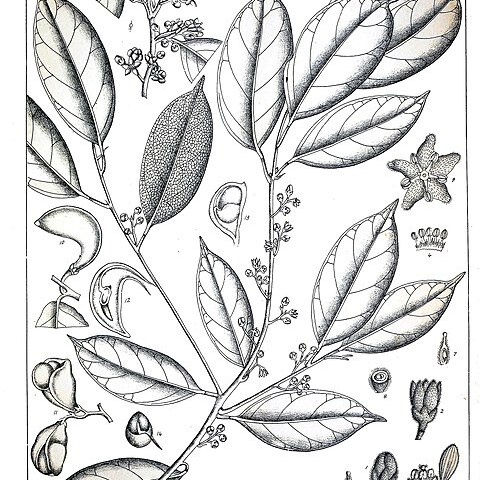Shrubs or small trees. Leaves unifoliolate. Inflorescences axillary, paniculate to glomerulous, small. Bracts early caducous, lanceolate, small. Flowers 4-5 merous, protandrous, bisexual or unisexual, in the latter case plants apparently dioecious. Sepals valvate in bud, outside densely pubescent. Petals free, cochlear-imbricate in bud, (greenish-or creamy-) white. Stamens twice as much as petals, connate at base, episepalous ones well developed, epipetalous ones staminodial, much smaller; the tube outside glabrous, inside pilose. Pistil 1, pilose, somewhat laterally inserted; ovary oblique, flattened ovoid; style slender; stigma disk-shaped to bilobed, rather large. Fruits densely tomentose, yellowish to brownish when ripe, slightly to strongly dorsally geniculate, the basal part constricted into a short to long stipe, the fertile part more or less (flattened-)ovoid, fertile part opening lengthwise by a slit; pericarp woody; calyx persistent, not accrescent. Seed 1, ellipsoid, blunt at both ends, shining black, the basal part covered with a yellowish to orange arilloid; endosperm about 1 mm thick, hard.
Shrubs or small trees, with unifoliolate, alternate leaves. Inflorescences racemose or paniculate, axillary. Flowers with dimorphic androecium and gynoecium. Sepals 5, ± valvate. Petals 5, glabrous to pubescent. Stamens 10; 5 episepalous fertile, longer than 5 epipetalous staminodes; all connate into a basal tube, tube hairy internally. Carpel solitary, ovary and style villous, stigma capitate, ovules inserted on ventral suture. Fruit an ovoid, obliquely pyriform or cymbiform follicle, acute at apex, narrowed into a basal stipe, densely hairy externally; dehiscence by ventral suture, seed retained but exposed within pericarp, the latter splitting from apex towards base, pericarp dry and tough at maturity. Testa of seed dark and shining, aril ± basal, oblique, membranous; endosperm present, forming a thin layer around cotyledons, the latter fleshy, somewhat flattened, radicle apical.

